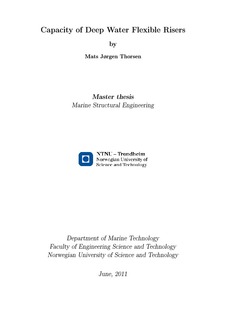| dc.description.abstract | A flexible riser operating in deep water will experience large environmental forces. Due to the length of the riser, dynamic tension from drag forces will be substantial. The tensile force is transferred directly into the end fitting, and fatigue damage may be critical at this point. In addition, the large hydrostatic pressure at the ocean floor may induce compressive stresses in the tensile armor, something this component is not designed for. In connection with these challenges, this thesis deals with two different phenomenons relevant for deep water risers:
Local stresses in tensile armor wires at the end fitting due to contraint effects.Radial and lateral buckling of tensile armor wires.
The first part of this report, section 2 and 3, is the result of a literature study regarding flexible pipe technology, failure modes and design criteria with special focus on those relevant for deep water applications. In section 4, theory important to the thesis work is presented. This includes analytical methods for stress analysis of flexible pipes, theory of thin curved beams, basic theory of restrained warping and finite element methods.
In the last part of section 4, a new curved beam element for the nonlinear finite element program Aflex is presented. A central part of the thesis work has been to implement this new element into the original Aflex code. The element has rotational degrees of freedom about the bi-normal direction in addition to the degrees of freedom included in the original Aflex code. Hence, the element is capable of investigating both radial and lateral buckling modes. The element has also been implemented in a special version of the Bflex2010 computer program.
Section 5 is dedicated to analyses of stresses in tensile armor wires at the end fitting. The load case considered is axial straining of the pipe, which leads to a small change in lay angle. As the wires are restrained at the end fitting, a change in lay angle will not be allowed, and this constraint will induce local stresses. First, analytical calculations neglecting friction between the armor wire and supporting layer are performed for different wire dimensions. Next, the new curved beam element is used for numerical analyses of the same cases, and the transverse bending stress at the end fixation is studied for varying friction coeffcients. Both analytical and numerical results show that the relative magnitude of the local transverse bending stress increases as the axial straining of the pipe increase. As an example, the bending stress is found to exceed 16 % of the nominal axial stress when the axial stress is 400 MPa, for a flexible pipe including two tensile armor layers and a friction coeffcient of 0.15.
Section 6 deals with different buckling modes for tensile armor wires. Three different modes are presented, namely radial failure due to anti buckling tape rupture, radial elastic buckling and lateral buckling. Analytical formulas for predicting the capacity with respect to all three modes are established, and governing physical effects are discussed. Numerical analyses with the new curved beam element are performed, and the results are compared to the analytical solutions. It is found that the first radial failure mode is determined primarily by the strength of the anti buckling tape, while the elasticity of the tape is critical to the second radial mode. Comparison between the analytical solutions and finite element results indicate that the radial failure modes are accurately predicted by both methods.
The lateral buckling capacity is more diffcult to predict, as the behaviour is dominated by friction forces, and the stick-slip transition. However, analytical and numerical results all indicate a strong dependence upon friction coeffcient and pipe curvature. The finite element model reports the lowest capacity, and these results are also believed to be the most accurate due to the more realistic modelling of friction.
A smaller investigation of the lateral buckling capacity under cyclic curvature is done with the FE model, and it is found that buckling of tensile armor wires may occur after a number of curvature cycles even if the combination of stress and curvature is significantly lower than critical in static curvature conditions. The results from these analyses are unfortunately somewhat unclear, as they were found to be slightly influenced by the numerical parameters defining the friction springs. Nevertheless it is concluded that lateral buckling may occur as a result of gradual transverse slip under cyclic curvature conditions, and that this may happen for curvatures in the vicinity of 0.1 m−1 combined with a compressive stress in the armor wire equal to 300 MPa, given a friction coefficient of 0.15.
| nb_NO |
